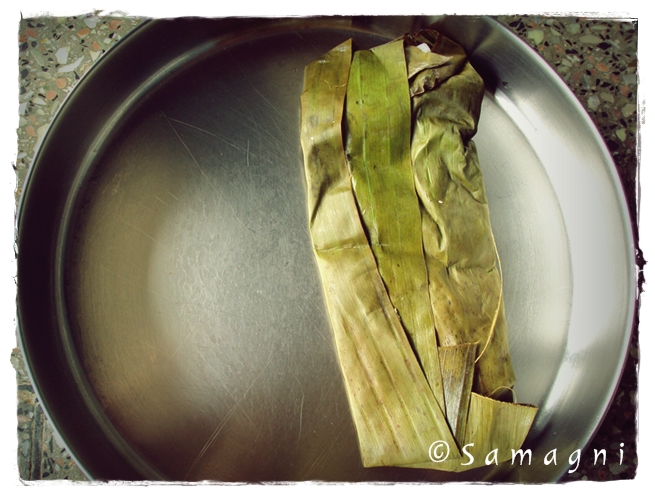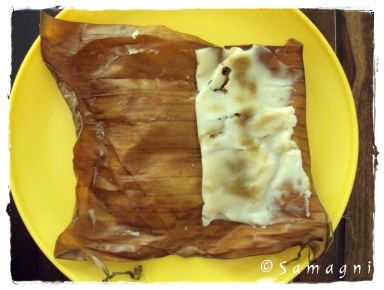
Ela in Malayalam means leaf (in this case banana leaf) and ada means thick flat bread. Back home at Palakkad, ela ada is a must item on the day of Thiruvonam (harvest festival in Kerala) and sure shot on the menu when special people visit home. Ela ada, although a little time consuming, is a fairly easy dish to make. Nothing can go wrong with an ela ada. A mix of coconut and jaggery cannot be anything short of yummy. Simply coat this with a rice paste and steam it, and these sweet parcels are ready.

The ela ada filling offers a lot of room for creativity. My mother makes three versions, to be precise 4. One with the jaggery and coconut filling; another with jaggery, coconut, and jackfruit jam filling; another with coconut and sugar filling; and the one with coconut and salt filling. I have heard that in other parts of Kerala ela ada is made with beaten rice, jaggery, and banana pieces as fillings. Although I have never had this, it definitely sounds interesting.
Another reason ela ada is so unique is because they are steamed and contain no oil. One can eat them without feeling guilty although diabetics need to watch out for all that jaggery! Still, its better than sugar intake.
On a day my mother decides to make ela ada, all of us are in high spirits. We split the chores and participate in all the tasks, especially hunting for the banana leaves, cleaning the leaves and tearing them into appropriate pieces, adequately drying them in the sun, grating the coconut, and spreading the rice batter on the leaves. The filling is irresistibly tasty and as soon as it is made, a good portion of it disappears quickly into our tummies. Enough ranting about the ela ada. Let’s look at how to make these wrapped up irresistibles.
Ingredients for filling:
Coconut – 1 (medium size)
Jaggery – 250 gms
Jack fruit jam/Chakka Varatti – 1 cup (optional)
Cardamom/Elaichi powder – 1/2 tsp
Water – 1/2 cup
Method:
Grate the coconut and keep aside. Heat a thick deep bottomed vessel (kadai). Pour water and add jaggery. Let it melt completely. Turn off the fire and sieve to remove dirt from the jaggery. Clean the kadai and pour the jaggery syrup into the kadai and turn on the heat to medium. The syrup starts foaming and then settles down to thicken. Add the grated coconut and stir. When the water reduces and mixture thickens, add the jackfruit jam and elaichi powder. Remove from fire.
This is the stage where my mother has to fiercely guard the filling from me lest there is none left when it is finally time to make the ada! <<wicked grin>> On a more serious note, this filling is extremely tempting and is as good to be had without any further additions.
Ingredients for rice paste:
Raw rice (or rice powder) – 250 gms
Water – As needed
Gingely oil/til oil (optional) – 1 tsp

Method:
You can make the batter in two different ways. The first method is more preferable as it gives better results where the rice coating on the adai is softer and does not stick to the outer leaf at all.
Method 1: Heat a cup of water and bring to boiling point. Once it starts bubbling, turn off the heat and add small quantities to the rice flour use a ladle to mix the water into the rice flour. Add a pinch of salt. Mix well to make a soft and firm dough. The consistency should be similar to that of idiyappam dough or modakam dough. Keep aside.
Method 2: Wash the rice and soak it in water for around 2-3 hours. Grind to make a fine and smooth paste. The batter should not be too watery or very thick. The consistency should be such that you should be able to spread it on a leaf using the back of a spatula. If you are using rice powder, simply mix water to the rice powder to prepare the batter. Keep the batter aside. You can add the gingely oil to the batter at this stage. This is optional. Wash, clean, and cut the banana leaves into small rectangle or square pieces. Turn on the gas stove flame to medium and show the banana leaf over the flame lightly ensuring that the leaf turns color but does not get burnt. This makes the leaf flexible and it can be folded easily without it breaking or causing it to tear.
Take the banana leaf bit and spread it inner side facing up. Take a ladle full of rice batter and spread it across the leaf leaving half inch space free on all sides. The rice batter should be spread like a thick dosa. If you are using the first method to make a tight dough of the rice flour, you may take a fistful of rice dough and use your fingers to pat it gently and spread a thin layer of dough on the leaf.

Take a spoon full of the filling and place it on one side of the rice spread on the banana leaf. Spread the filling in such a way that half the area of the spread rice should have the sweet filling as a topping.

Grab the two ends of the leaf where the rice batter is without topping and fold this to the other ends of the leaf. Now the leaf has one folded side and three open sides. Lightly fold the top of the leaf and then the sides of the leaf that are open to make a sealed packet.
Repeat these steps to make similar packets until you either run out of batter, filling, or leaves. Leftover filling is not a problem at all. It is so delicious by itself and can be finished in a jiffy!
If you run out of filling mid way, instead of the filling you could add some grated coconut and sprinkle a spoon of sugar and make these sweet parcels. If you have a diabetic in the house, you could add adequate salt to the leftover batter, spread it on the leaf, and add grated coconut. You see, there is a parcel for everyone!
Arrange the sealed packets on an idli stand and steam cook for around 10-15 minutes. Turn off and allow it to cool for 5 minutes.

When you open the packet, if the filling or the rice batter sticks only to one side, then it means that it is adequately cooked.



The aroma of steamed banana leaf combined with jaggery, jackfruit jam, and rice is heavenly.

I just so love the one with the jaggery and coconut filling!
Cravings…
LikeLike
Last time i made it, you missed it. There shall be a next time soon 🙂
LikeLike
Hi,
I just had one of these in a Udipi Resuarent. I liked it so much that I searched and found it here. Thank you so much!
LikeLike
Thanks for letting me know that, Arpana. Hope you try it out. Good luck! 🙂
LikeLike
These sweet parcels look super-yummy! Don’t know if I can make them.
LikeLike
Thanks Rakhee. They are simple and easy to make. Do try 🙂
LikeLike
This is an all time favourite of my family. We, in the south, too make it in the 3-4 versions made in your side. Today is especially the day of Ada in our area – VavAda.
LikeLike
Thank you for stopping by Indu. I first heard about VavAda today. Did you make it today? Is it in anyway different from the ada made at other times?
LikeLike
This recipe reminds me of the ukadiche modak we Maharashtrians make on Ganesh Chaturthi. Loved the pics, made my mouth water. 🙂
LikeLike
Yes Mukta. This is so similar to Modak. Only that here the rice batter is spread on a banana leaf and steamed. 🙂
LikeLike
Hello Manju,
Hope you got ‘ada’ picture.Finally we made it. Thanks a lot for the tips!
LikeLike